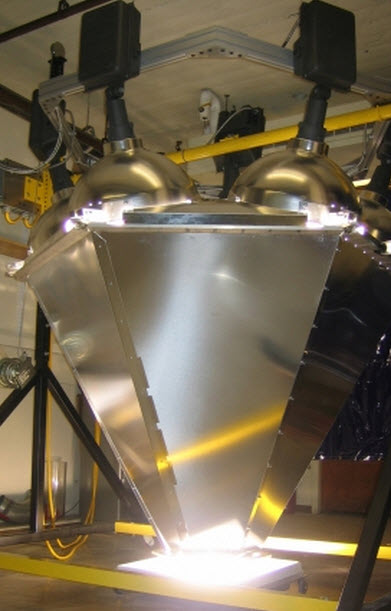How to make solar power available 24/7
August 1, 2011

Small-scale laboratory setup was used to test the ability of a container of molten salt to absorb and store heat from concentrated sunlight, simulated using powerful spotlights. (Credit: Alexander Slocum et al.)
Researchers at MIT have designed a concentrated solar thermal system that could store heat in vats of molten salt, supplying constant power.
CSPonD (for Concentrated Solar Power on Demand) combines heating and storage in a single tank that is mounted on the ground instead of a tower. The heavily insulated tank admits concentrated sunlight through a narrow opening at its top, and features a movable horizontal plate to separate the heated salt on top from the colder salt below. (Salts are generally used in such systems because of their high capacity for absorbing heat and their wide range of useful operating temperatures.)
As the salt heats over the course of a sunny day, this barrier gradually moves lower in the tank, accommodating the increasing volume of hot salt. Water circulating around the tank gets heated by the salt, turning to steam to drive a turbine whenever power is needed.
The new system could be more durable than existing tower-based concentrated solar power (CSP) systems, which require expensive pumps and plumbing to transport molten salt and transfer heat, the researchers said. Existing CSP heat-absorbing receivers cool down at night or on cloudy days.
“It’s the swings in temperature that cause [metal] fatigue and failure,” says professor Alexander Slocum. He explains that using the traditional way to address temperature swings, “You have to way oversize” the system’s components. “That adds cost and reduces efficiency.”
The team has carried out small-scale tests of CSPonD’s performance, but its members say larger tests will be needed to refine the engineering design for a full-scale powerplant. They hope to produce a 20- to 100-kilowatt demonstration system to test the performance of their tank, which in operation would reach temperatures in excess of 500 degrees Celsius.
Ref.: Alexander H. Slocum, et al., Concentrated solar power on demand, Solar Energy, 2011; [DOI:10.1016/j.solener.2011.04.010]